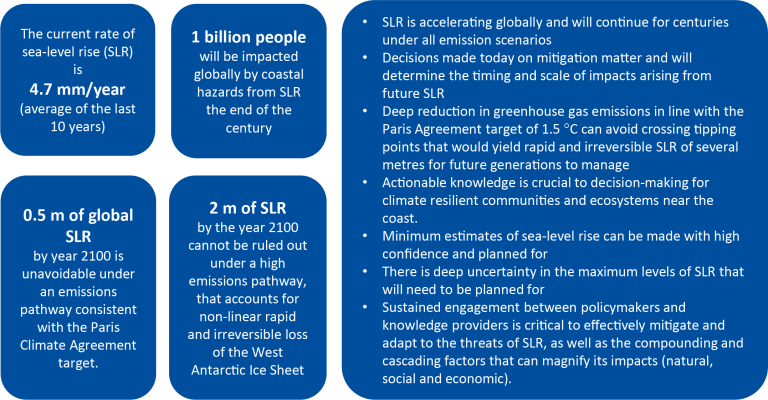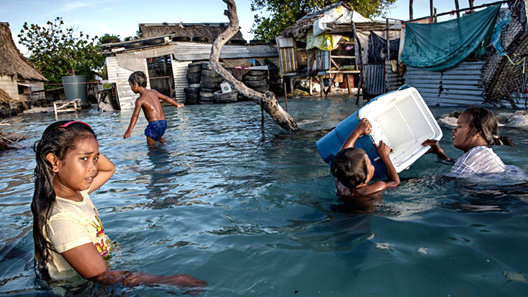Outline of the current state and understanding of global sea-level rise and policy relevant information
The WMO co-sponsored World Climate Research Programme (WCRP)1 is at the forefront of sea-level change research. At the request of WMO Members and other United Nations entities, WCRP has developed a status brief on current and projected sea-level rise (SLR), and the related challenges that the global community of scientists are addressing, to better understand processes and reduce uncertainties. This continuing research allows WMO to improve, over time, actionable sea-level risk information for society as synthesized in the brief. In this extended version for the WMO Bulletin, we outline the current state and understanding of global sea-level rise science and provide policy relevant information for users and decision-makers.
Why does sea-level rise matter?
SLR is one of the clearest planet‐wide consequences of climate change. Global mean sea-level (GMSL) has risen 20 centimetres (cm) since the early 20th century. The rate of SLR is accelerating and will continue to rise under all emissions scenarios well beyond the end of the 21st century (IPCC 2023). SLR impacts coastal communities, infrastructure and ecosystems through permanent inundation of the lowest-lying areas and by increasing the frequency of flooding. Added to this are associated impacts such as erosion, groundwater inundation, and aquifer and floodplain salinization affecting wider coastal environments. Coastal hazards and their impacts are now occurring worldwide, and their near-term risks are projected to escalate well before 2050. One billion people living in coastal areas will be impacted by the end of the century (IPCC 2023) (see the box below).
The ability to anticipate and adapt to SLR and curtail its acceleration beyond 2050 will determine how society copes with increasing coastal risks. This ability depends on access to context-specific risk information and strategies tailored to unique local environmental, cultural and social settings, as well as near-term and ongoing commitment to emissions mitigation. There are hard limits to adaptation in the face of progressive SLR, because SLR may become irreversible this century. Coastal inundation already threatens habitability and sovereignty for some small-island developing states. Some communities, for example in Tuvalu and Fiji, are already implementing relocation or managed retreat from their coastlines or exploring new visions of a digital community (Rothe et al., 2024).

How much and how fast is sea-level rising?
GMSL rise depends almost equally on two main contributors, both of which are highly sensitive to ongoing climate change: the expansion of ocean waters as they warm, and meltwater contributions from ice on land - the Antarctic and Greenland ice sheets as well as thousands of smaller mountain glaciers (e.g. Liang et al. 2025). Global sea-level rise is accelerating: 2024 recorded an increase of 5.9 mm, relative to a mean annual average rate of 3.4 mm/year between 1993-2024 and 4.7 mm/ year between 2014-2023, due to an accelerating rate of land ice loss and recent exceptional rates of atmospheric and ocean warming (Hamlington et al. 2025, Liang et al. 2025). Trends based on tide gauge sea-level data from 1970-2023, extrapolated forward to 2050, support mid-range Intergovernmental Panel on Climate Change projections (IPCC, 2021) of sea-level change by 2050 and highlight the value of observational constraints on model projections (Wang et al. 2025). The likely (17th-83rd percentile) range of global mean SLR for the end of the century for all climate scenarios is between 0.4-1 m (Figure 1).
What are some of the consequences of sea-level rise? It is estimated that between 4 and 72 million people, with the greatest numbers in Bangladesh, India and Vietnam, but many affected elsewhere, will need to migrate between 2020 and 2100, due to a net land loss of 2 800 to 490 000 km2 (Ballesteros et al. 2025). In Bangladesh alone, it is estimated that 15 million will be displaced by 2050 (IPCC, 2019). Across the range of socioeconomic scenarios considered by IPCC AR6, the greatest estimated migration is under the "high mid-range" SSP3-7.0 scenario, due to population and economic differences between the scenarios (Ballesteros et al. 2025).
Sea level will not rise evenly around the world's shorelines. While global average SLR is often quoted, the rate and magnitude of future SLR will be different in various regions depending on which polar ice sheets melt the fastest and due to the influences of mass redistribution on Earth's gravitational field, axis of rotation and the shape of the Earth's surface, as well as regional changes in ocean and atmospheric dynamics (IPCC, 2021). Examples of these regional differences in SLR include: (i) the western equatorial Pacific where rates of SLR are up to 20 mm/year due to regional ocean heating, and (ii) the US coastline, which could see up to 20% more SLR than the global average, if the West Antarctic Ice Sheet melts dramatically. Moreover, local land subsidence due to tectonics, groundwater and fluid extraction and compaction from the weight of industrialization (e.g., Ohenhen, 2023) can exacerbate the rate of SLR. Adaptation planning decision thresholds, such as those linked to the impacts of coastal flooding and inundation, may be brought forward by decades (Naish et al., 2024).

The magnitude and rate of future sea-level rise is uncertain
Despite recent advances in ice-sheet modelling, deep uncertainty remains about the possible impact of accelerating ice-mass loss from the Antarctic Ice Sheets on the high-range of sea-level projections, especially beyond the 21st century, due to limitations in understanding and representing physical processes at ice margins and their feedback in the climate system (Fricker et al. 2025, Kopp et al. 2023). This includes potential runaway processes such as "Marine Ice Cliff Instability". Scientists are still unable to discount some low probability, but potentially catastrophic, very high-end sea-level scenarios that go well beyond the upper likely range of the high emissions IPCC scenario (~102 cm global rise) by 2100 (DeConto et al., 2021). For this reason, the IPCC (2021) Report stated that 2 m SLR by the end of the century could not be ruled out. Therefore, further improvements to the models and their forcing datasets (e.g. ocean circulation) together with enhanced observations, and an improved understanding of key rate determining processes, are urgently needed (Fricker et al. 2025, Williams et al. 2025). Differences between the forcing datasets from different climate models dominate uncertainties in global and regional sealevel projections, at least until around 2070 (Jin et al. 2025). After this time, the uncertainty is dependent on emissions mitigation pathway and Antarctic ice sheet melting dynamics. A recent study indicates that global warming needs to be stabilized well below 1.5 °C above pre-industrial, to avoid damaging (multimetre) levels of sea-level rise over the next few centuries (Stokes et al. 2025). Paleoclimate archives show in response to 1.5 °C and 2.5 °C of global warming, sea levels rose up to +9 m and +20 m, respectively, occurring over centuries.
Uncertainties in mean and extreme sea-level projections are further compounded by local factors that affect the rates of vertical land movement (VLM; discussed above), which can be as fast as the rate of global sea-level rise. The direction of VLM can significantly offset or exacerbate the local change in sea level, known as relative sea level (RSL). These processes driving RSL change are presently poorly represented in models and sea-level projections used for local coastal hazard and risk assessments.

Research priorities
Currently, the ice-sheet modelling community is gearing up for a new model intercomparison project called Ice Sheet Model Intercomparison Project 7 (ISMIP7). This is a WCRP Climate and Cryosphere (CliC) -sponsored project that will contribute to the IPCC AR7 cycle and promises to make further advances by spearheading the international scientific community to improve climate and ice-sheet projections, which in turn will reduce uncertainty regarding future sea-level change. At the same time, practitioners and users of SLR data are asking for consistency in actionable information to support decision-making and planning for coastal resilience (Hirschfeld et al., 2023). This requires that researchers and users work more effectively together on the provision and communication of sea-level rise science and information and the treatment of uncertainty related to global (Antarctic ice sheet) and local (vertical land movements) drivers of SLR. Recognizing the importance of understanding the impacts of rising sea levels, WCRP itself is discussing a possible future sea level focused activity to bring together the various aspects of sea-level research and impacts into a single focused activity.
The authors acknowledge the support of Carlos Montoya in preparing this article.
References
Ballesteros, C., Lincke, D., Nicholls, R., Heslop, J., Jochen, H., Malagón-Santos, V., Slangen, A. 2025. Migration, land loss and costs to 2100 due to coastal flooding under the IPCC AR6 sea-level rise scenarios and plausible adaptation choices. Frontiers in Marine Science, 12, doi: 10.3389/fmars.2025.1505633
BongartsLebbe, T., ReValette, H., Chaumillon, É., Camus, G., Almar, R., Cazenave, A., Claudet, J., Rocle N., MeFérec, C., Viard, F., Mercier, D., Dupuy, C., Ménard, F., Rossel, BA., Mullineaux, L., Sicre, MA., Zivian, A Gaill, F., and Euzen, A. 2021. Designing coastal adaptation strategies to tackle sea level rise. Frontiers in Marine Science 8, 740602. https://doi.org/10.3389/ fmars.2021.740602
DeConto, R.M., Pollard, D., Alley, R.B. et al. 2021. The Paris Climate Agreement and future sea-level rise from Antarctica. Nature 593, 83-89. https:// doi.org/10.1038/s41586-021-03427-0
Fricker, A., Galton-Fenzi., Colello Walker, C., Isabella, B., Freer, D., Padamn, L., DeConto, R. 2025. Antarctica in 2025: Drivers of deep uncertainty in projected ice loss. 601 609. doi: 10.1126/science.adt9619.
Hamlington, B.D., Fournier, S., Thompson, P.R. et al. Sea level rise in 2024. 2025. Nature Reviews Earth Environment 6, 246-248. https://doi.org/10.1038/s43017-025-00667-w
Hirschfeld, D., Behar, D., Nicholls, R.J. et al. Global survey shows planners use widely varying sea-level rise projections for coastal adaptation. Commun Earth Environ 4, 102 (2023). https://doi.org/10.1038/ s43247-023-00703-x
IPCC, 2019: IPCC Special Report on the Ocean and Cryosphere in a Changing Climate [H.‑O. Pörtner, D.C. Roberts, V. MassonDelmotte, P. Zhai, M. Tignor, E. Poloczanska, K. Mintenbeck, A. Alegría, M. Nicolai, A. Okem, J. Petzold, B. Rama, N.M. Weyer (eds.)]. Cambridge University Press, Cambridge, UK and New York, NY, USA, 755 pp. https://doi. org/10.1017/9781009157964
IPCC, 2022. Climate Change 2022: Impacts, Adaptation, and Vulnerability. Contribution of Working Group II to the Sixth Assessment Report of the Intergovernmental Panel on Climate Change [H.-O. Pörtner, D.C. Roberts, M. Tignor, E.S. Poloczanska, K. Mintenbeck, A. Alegría, M. Craig, S. Langsdorf, S. Löschke, V. Möller, A. Okem, B. Rama (eds.)]. Cambridge University Press. Cambridge University Press, Cambridge, UK and New York, NY, USA, 3056 pp., doi: 10.1017/9781009325844
IPCC, 2021. Climate Change 2021: The Physical Science Basis. Contribution of Working Group I to the Sixth Assessment Report of the Intergovernmental Panel on Climate Change[Masson-Delmotte, V., P. Zhai, A. Pirani, S.L. Connors, C. Péan, S. Berger, N. Caud, Y. Chen, L. Goldfarb, M.I. Gomis, M. Huang, K. Leitzell, E. Lonnoy, J.B.R. Matthews, T.K. Maycock, T. Waterfield, O. Yelekçi, R. Yu, and B. Zhou (eds.)]. Cambridge University Press, Cambridge, United Kingdom and New York, NY, USA, In press, doi: 10.1017/9781009157896
IPCC, 2023. Summary for Policymakers. In: Climate Change 2023: Synthesis Report. Contribution of Working Groups I, II and III to the Sixth Assessment Report of the Intergovernmental Panel on Climate Change. IPCC, Geneva, Switzerland, pp. 1-34, doi: 10.59327/IPCC/ AR6-9789291691647.001
Jin, C., Liu, H., Lin, P., Lyu, K., & Li, Y. 2025. Uncertainties in the projection of sterodynamic sea level in CMIP6 models. Geophysical Research Letters, 52, e2024GL113691. https:// doi.org/10.1029/2024GL113691
Kopp, R.E., Oppenheimer, M., O'Reilly, J.L. et al. Communicating future sea-level rise uncertainty and ambiguity to assessment users. Nature. Climate. Change. 13, 648-660 (2023). https://doi.org/10.1038/ s41558-023-01691-8
Liang, T., Hsiao, S., Wu, H., Chen, H., Chen, W., 2025. Accelerated Ocean thermal expansion and its contribution to Global Sea-level rise, Journal of Sea Research, 205, 102589 https://doi.org/10.1016/j.seares.2025.102589
Naish, T., Levy, R., Hamling, I.,Hreinsdóttir, S., Kumar, P., Garner, G. G.,et al. (2024). The significance of inter seismic vertical land movement at convergent plate boundaries in probabilistic sea‐level projections for AR6 scenarios: The New Zealand case. Earth's Future, 12, e2023EF004165. https://doi. org/10.1029/2023EF004165
Ohenhen, L.O., Shirzaei, M., Ojha, C. et al. Disappearing cities on US coasts. Nature 627, 108-115 (2024). https://doi.org/10.1038/ s41586-024-07038-3
Rothe, D., I. Boas, C. Farbotko and T. Kitara (2024) 'Digital Tuvalu: state sovereignty in a world of climate loss', International Affairs, 100 (4), pp.1491-509, https://doi.org/10.1093/ia/iiae060
Stokes, C.R., Bamber, J.L., Dutton, A. et al. 2025. Warming of +1.5°C is too high for polar ice sheets. Communications Earth Environment 6, 351 (2025). https://doi.org/10.1038/ s43247-025-02299-w
Wang, J., Zhang, X., Church, J. A., King, M., & Chen, X. 2025. Near-term future sea-level projections supported by extrapolation of tide-gauge observations. Geophysical Research Letters, 52, e2024GL112940. https:// doi.org/10.1029/2024GL112940
Williams, C.R., Thodoroff, P., Arthern, R.J. et al. 2025. Calculations of extreme sea level rise scenarios are strongly dependent on ice sheet model resolution. Communications Earth Environment 6, 60. https://doi.org/10.1038/ s43247-025-02010-z






